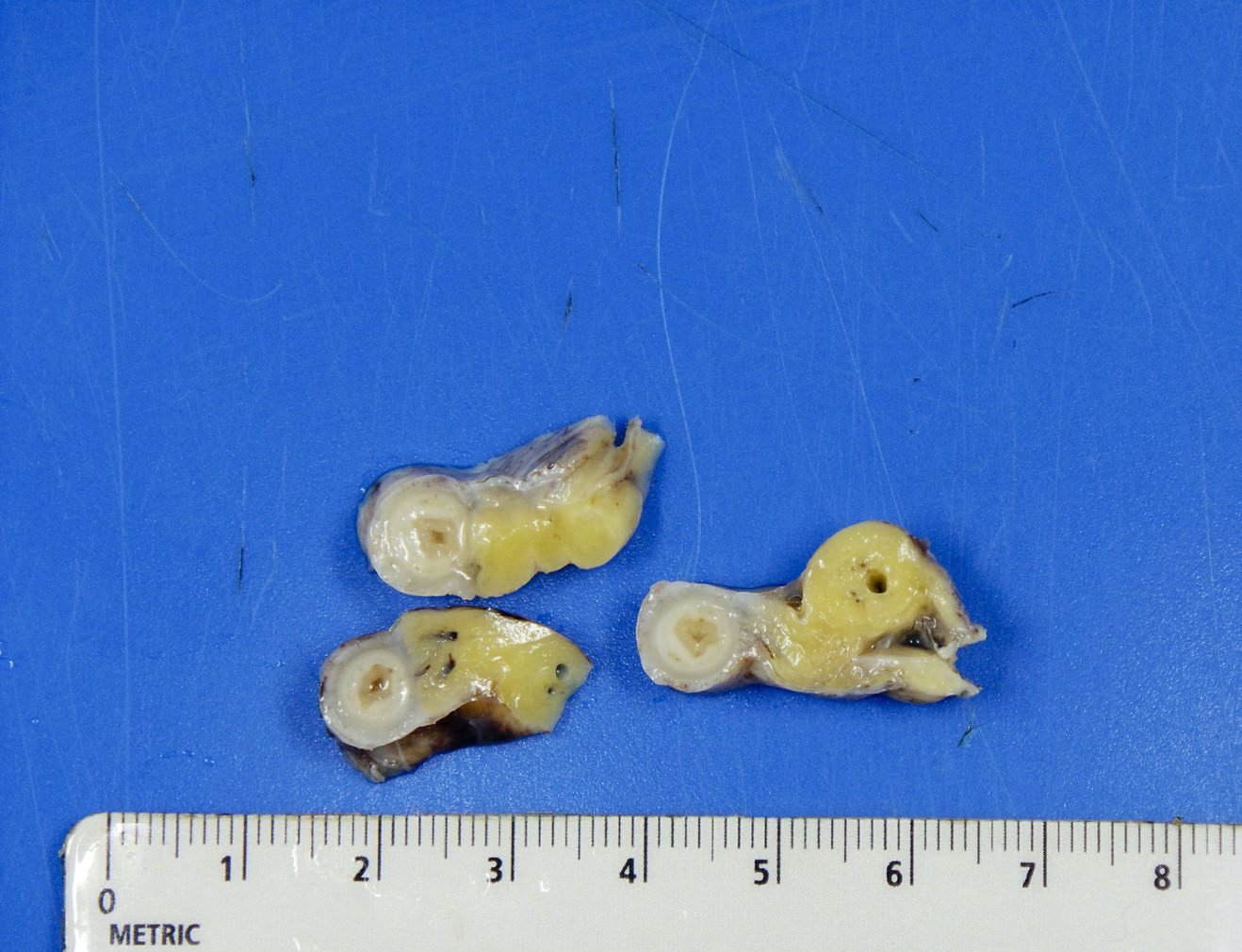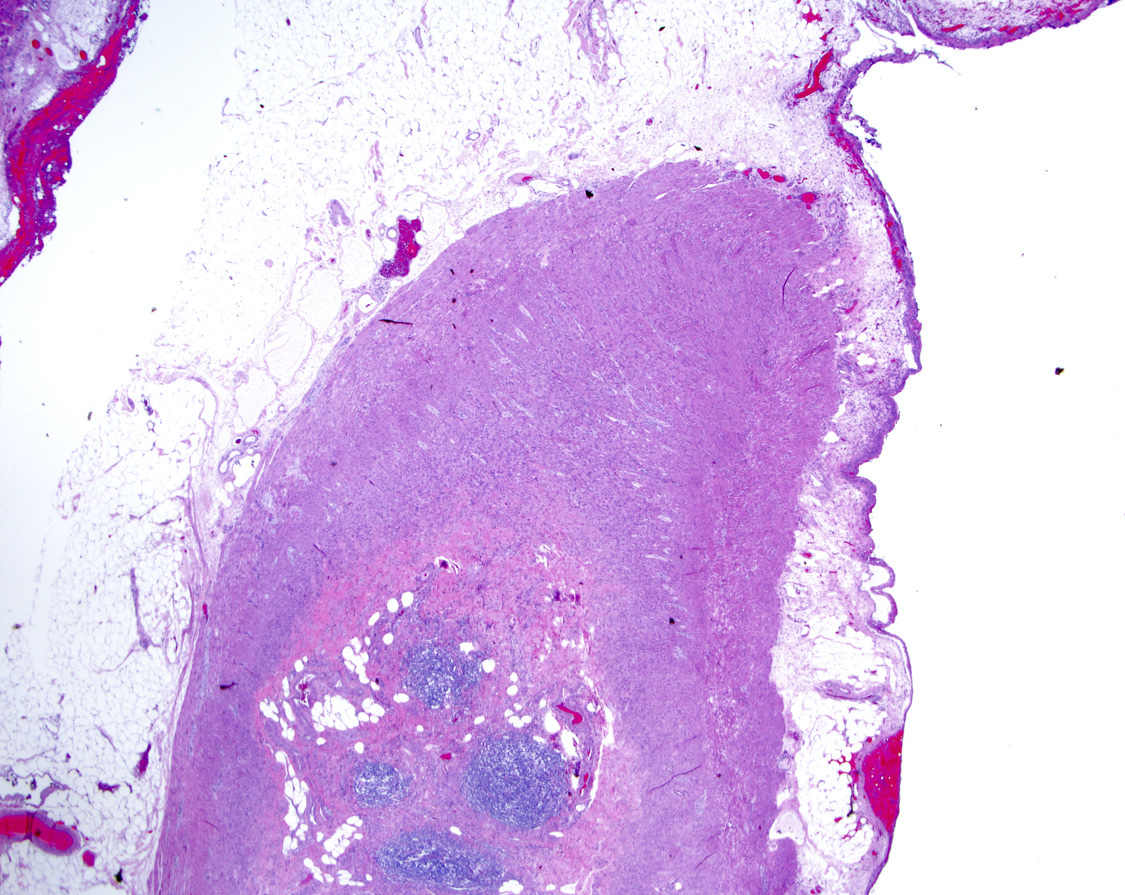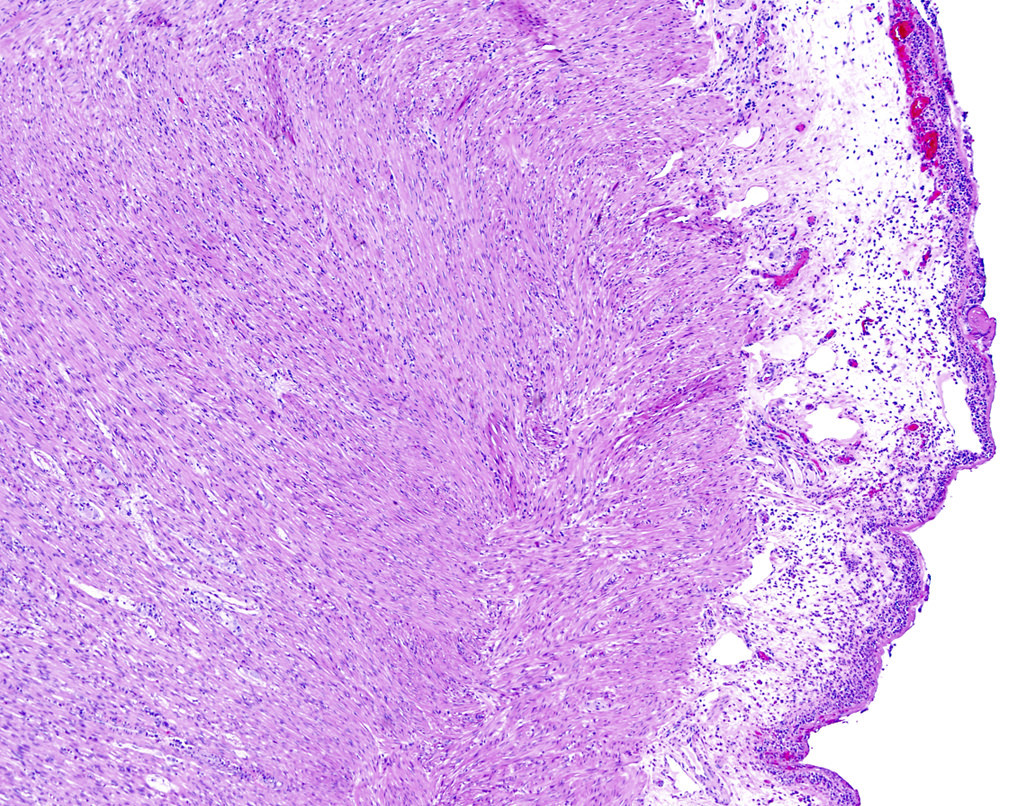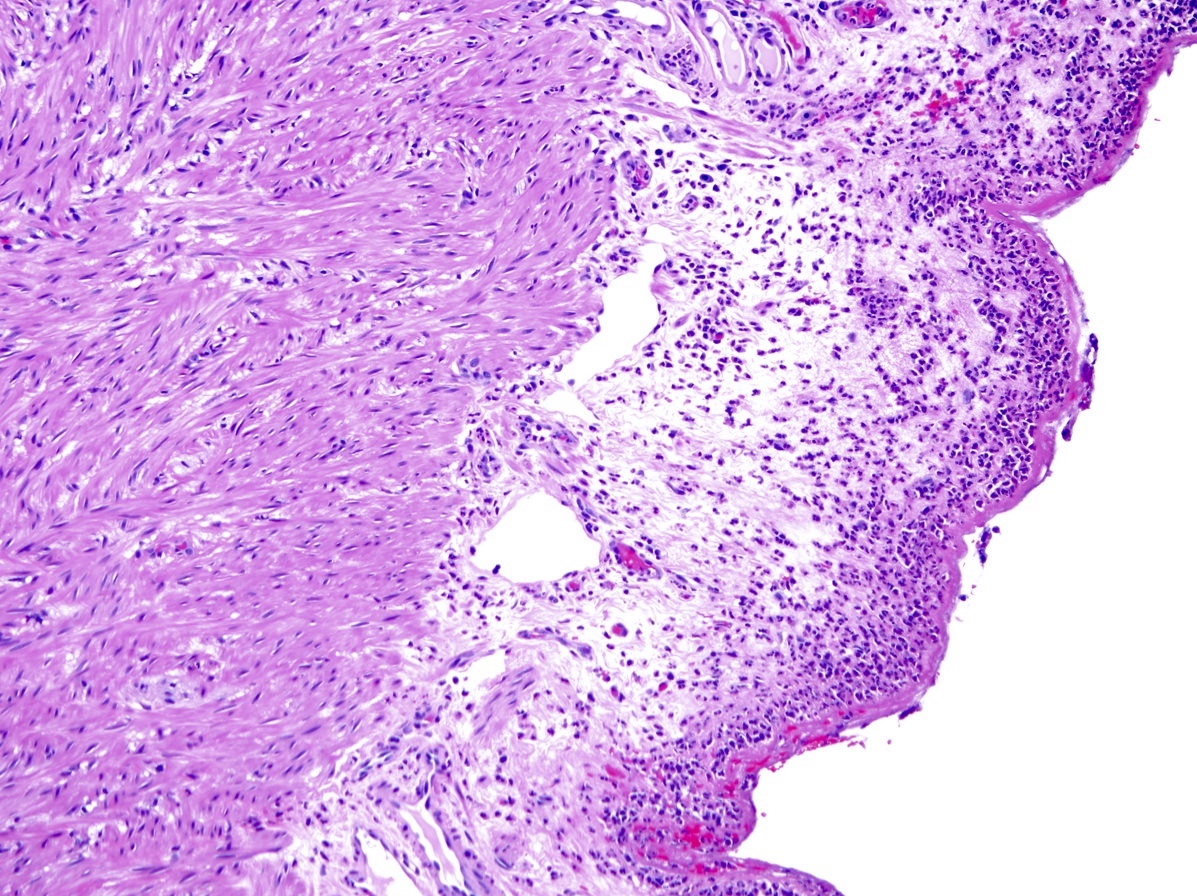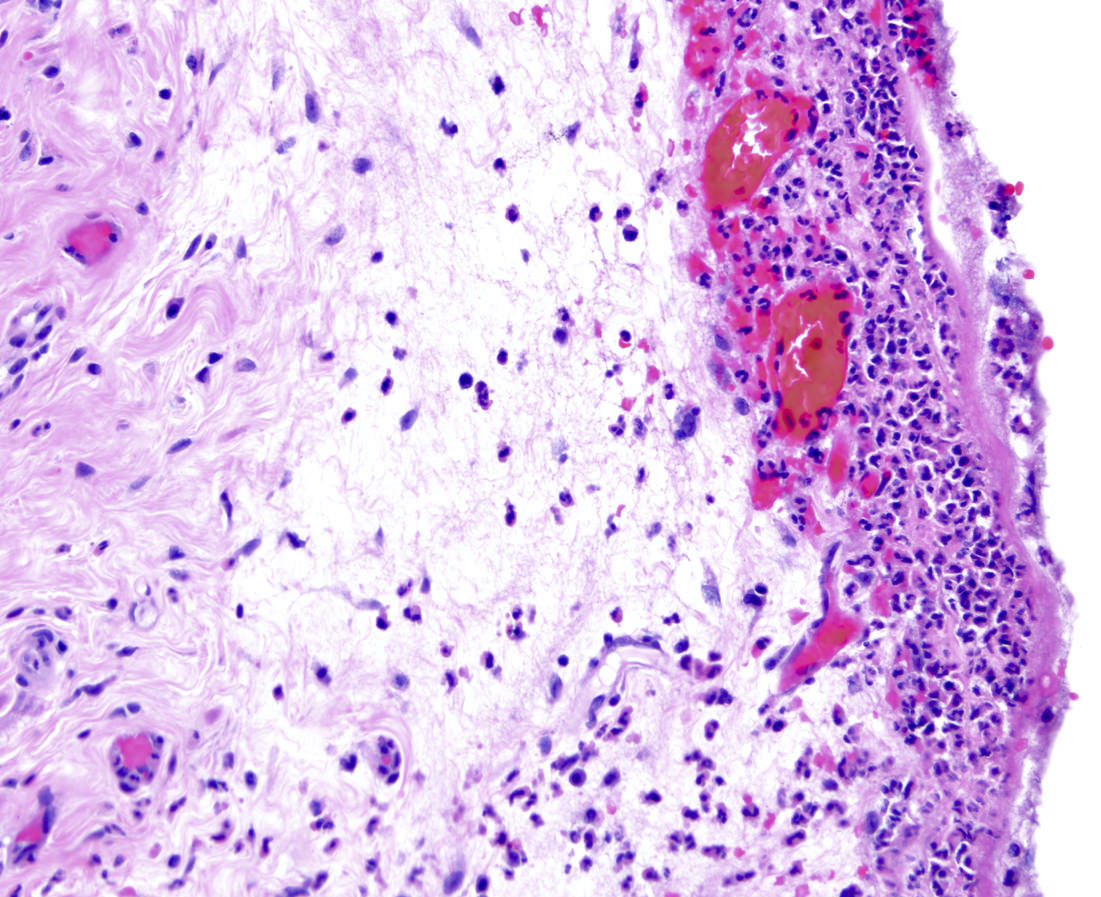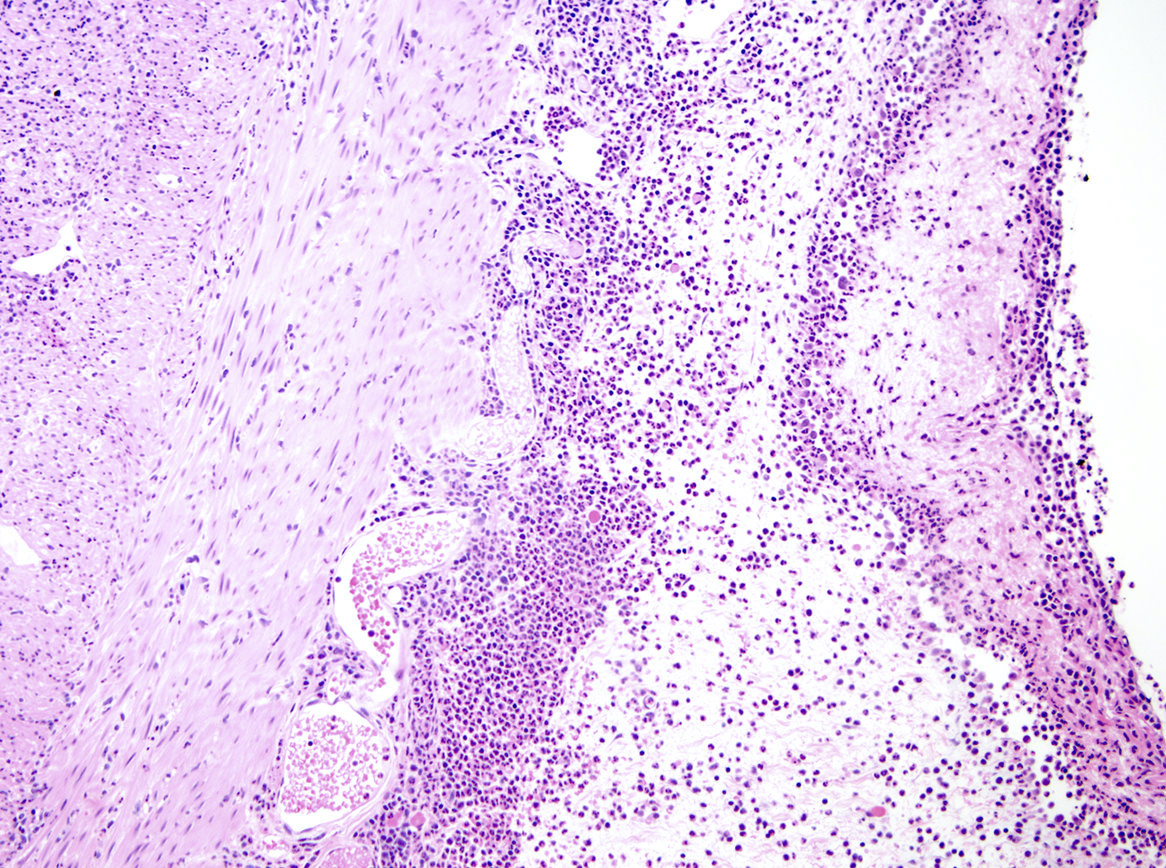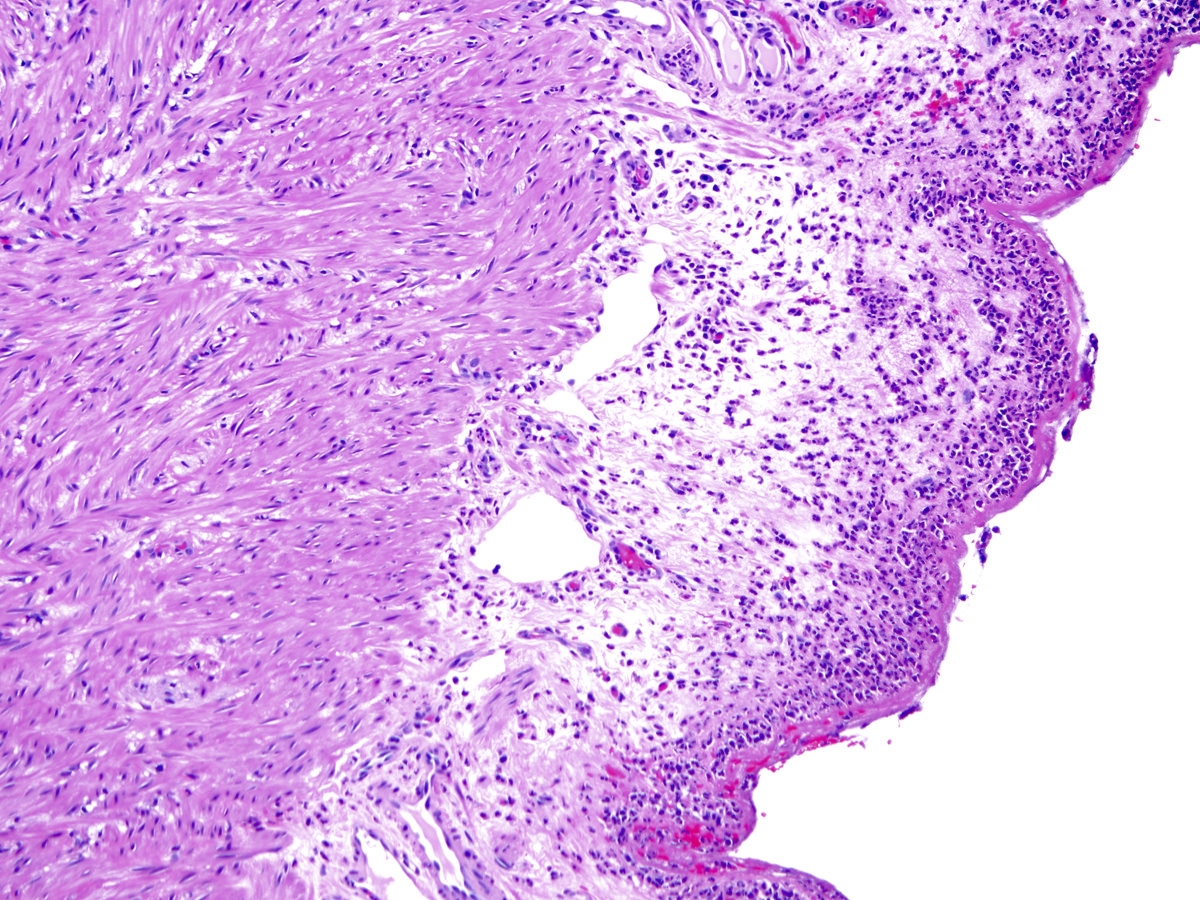Table of Contents
Definition / general | Essential features | Terminology | ICD coding | Epidemiology | Sites | Etiology | Clinical features | Laboratory | Radiology description | Prognostic factors | Case reports | Treatment | Gross description | Gross images | Frozen section description | Microscopic (histologic) description | Microscopic (histologic) images | Sample pathology report | Differential diagnosis | Additional references | Practice question #1 | Practice answer #1 | Practice question #2 | Practice answer #2Cite this page: Streich L, Pezhouh MK. Periappendicitis. PathologyOutlines.com website. https://www.pathologyoutlines.com/topic/appendixperiappendicitis.html. Accessed September 18th, 2025.
Definition / general
- Acute inflammation of the serosal surface of the appendix
Essential features
- Neutrophilic infiltrate in the serosa of the appendix
- Sparing of the appendiceal mucosa
- Serosal fibrin deposition
- No history of surgical manipulation
Terminology
- Appendiceal serositis, acute serositis
ICD coding
Epidemiology
- 1 - 5% of appendectomies for suspected acute appendicitis (Odze: Surgical Pathology of the GI Tract, Liver, Biliary Tract and Pancreas, 3rd Edition, 2014, Int J Surg 2014;12:1010)
- Most common in the pediatric population, though can present at any age
- In women: seen in relation to pelvic inflammatory disease and salpingitis
- In men: mostly associated with urologic conditions and infectious colitis
Sites
- Serosal surface of vermiform appendix
- Secondary to intra-abdominal inflammatory conditions
Etiology
- Periappendicitis is caused primarily by intra-abdominal pathology; acute salpingitis is the most common etiology (Odze: Surgical Pathology of the GI Tract, Liver, Biliary Tract and Pancreas, 3rd Edition, 2014)
- Attributed to many causes including (Am J Surg 1990;159:564)
- Salpingitis
- Pelvic inflammatory disease
- Infectious colitis
- Crohn's disease
- Colonic neoplasms
- Yersiniosis
- Meckel diverticulitis
- Abdominal aortic aneurysms
Clinical features
- Mimics the typical clinical presentation of appendicitis with leukocytosis, fever and lower right quadrant pain (Odze: Surgical Pathology of the GI Tract, Liver, Biliary Tract and Pancreas, 3rd Edition, 2014)
- One study showed more diffuse pain with a longer period of symptoms, as compared with appendicitis (Int J Surg 2014;12:1010)
- Importantly, will present with symptoms of the underlying pathology; for example, infectious colitis will present with diarrhea and diffuse abdominal pain, in addition to the above symptoms
Laboratory
- Leukocytosis, elevated inflammatory markers (Int J Surg 2014;12:1010)
Radiology description
- Diagnosis may be suspected based on imaging findings, including appendiceal enlargement and fat stranding with inflammatory changes on CT scan (Int J Surg 2014;12:1010)
- However, as with the clinical presentation, imaging findings overlap closely with appendicitis (Postgrad Med J 2006;82:830)
- Imaging findings may also reflect the underlying causative process
Prognostic factors
- Alone, it has unclear prognostic significance (Postgrad Med J 2006;82:830)
- Disease course will be largely dictated by prompt recognition and treatment of the underlying disease
Case reports
- 12 year old girl with pelvic inflammatory disease and periappendicitis (Radiat Med 2007;25:178)
- 29 year old man with a history of Crohn's disease treated with adalimumab, presenting with watery diarrhea and abdominal pain (Clin J Gastroenterol 2015;8:134)
- 29 year old man with delayed small bowel perforation and periappendicitis after blunt abdominal trauma (Acta Chir Belg 2009;109:234)
- 47 year old man with acute pancreatitis complicated by acute periappendicitis secondary to inflammatory exudate (Zhonghua Yi Xue Za Zhi (Taipei) 2002;65:619)
Treatment
- Definitive management should be directed at the underlying condition (Int J Surg 2014;12:1010)
- For infectious conditions of the peritoneum, refer to the guidelines published by the Infectious Disease Society of America
- Conditions such as abdominal aortic aneurysm require surgical management
- Management is generally appendectomy, although a growing body of evidence suggests conservative management with antibiotics may be sufficient
Gross description
- Excised appendix will demonstrate serosal changes in the absence of mural and mucosal change (Odze: Surgical Pathology of the GI Tract, Liver, Biliary Tract and Pancreas, 3rd Edition, 2014, Int J Surg 2014;12:1010)
- Serosa may appear roughened and may be covered with a fibrinous exudate
- Serosal adhesions may sometimes be seen
Frozen section description
- Will show inflammatory infiltrate in the serosa with sparing of the mucosa
Microscopic (histologic) description
- Acute inflammatory infiltrate in the serosa of the appendix (Odze: Surgical Pathology of the GI Tract, Liver, Biliary Tract and Pancreas, 3rd Edition, 2014, Int J Surg 2014;12:1010)
- Neutrophilic infiltrate may extend into the muscularis but the mucosa is spared in cases with only periappendicitis; however, similar histologic findings can be seen in acute appendicitis
- Involvement beyond serosa should prompt further examination of the specimen to evaluate for presence of acute appendicitis
Microscopic (histologic) images
Sample pathology report
- Appendix, appendectomy:
- Periappendicitis.
Differential diagnosis
- Acute appendicitis:
- Acute inflammation of the appendiceal mucosa
- Since serosal findings are common in acute appendicitis, examination of the entire appendix might be necessary in order to exclude this entity
- Periappendicitis due to endometriosis
- Periappendicitis due to other nonneoplastic or neoplastic processes involving the appendix
- Careful examination of the entire appendix can help excluding other possible etiologies
Additional references
Practice question #1
A 17 year old girl presents with a one day history of crampy right lower quadrant abdominal pain and fever. Imaging shows an enlarged appendix. Appendectomy is performed and on histologic examination the specimen shows neutrophilic infiltrate in the serosa, sparing the mucosa. What is the most likely underlying cause of periappendicitis?
- Acute appendicitis with perforation
- Acute salpingitis
- Inflammatory bowel disease
- Meckel's diverticulum
Practice answer #1
B. The patient has periappendicitis secondary to intra-abdominal inflammatory pathology. Salpingitis is the most common cause of acute periappendicitis. While inflammatory bowel disease
and Meckel diverticulum are both possible causes, they are less common. Acute appendicitis by
definition will involve the mucosa of the appendix.
Comment Here
Reference: Periappendicitis
Comment Here
Reference: Periappendicitis
Practice question #2
You receive an appendix for microscopic examination. You note that the patient has a history of treated Crohn's colitis and is currently hospitalized after partial colectomy. On examination, the appendiceal serosa shows scattered neutrophils without other pathologic change. What is the most likely cause of this finding?
- Acute appendicitis
- Previous surgery
- Salpingitis
Practice answer #2
B. Mild serosal neutrophilic infiltrate can occur after surgical manipulation of the appendix. Acute appendicitis is not the correct answer as the mucosa did not show any evidence of active inflammation. Although salpingitis is a possibility, the likelihood of that is less than mild inflammation due to prior surgery.
Comment Here
Reference: Periappendicitis
Comment Here
Reference: Periappendicitis



